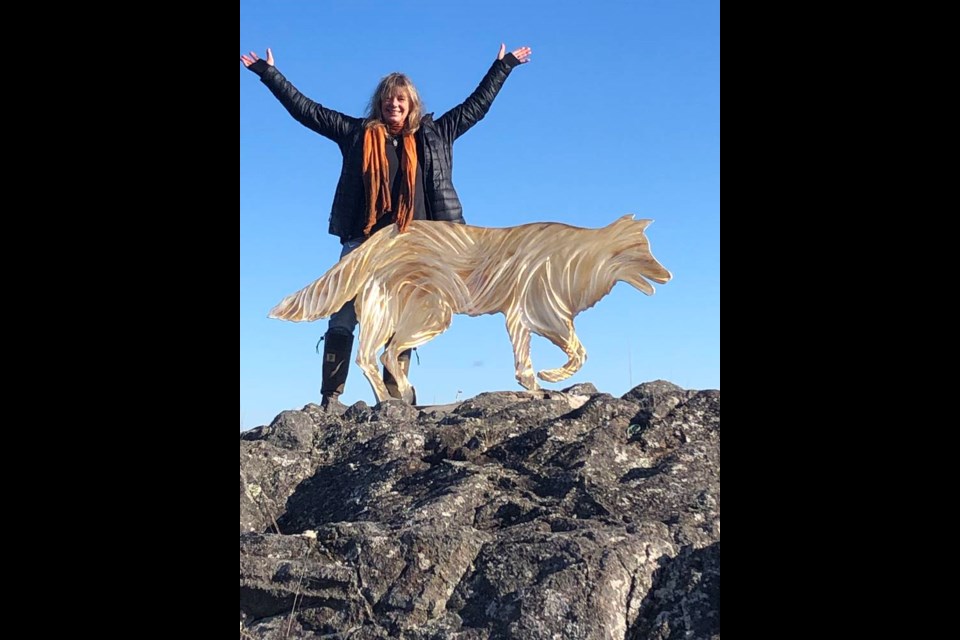Cheryl Alexander hasn’t been back to Discovery Island that much since Takaya died.
“It still feels a bit raw, knowing that he’s not here,” she says.
The Victoria woman was back Saturday, though, nosing her boat into a notch in the rocky shore while a nearby clutch of curious sea lions looked on.
The timing seemed right, given that it will be a year Monday since the wolf swam to Victoria for a two-day adventure that finally ended when conservation officers tranquillized it in James Bay. That episode thrilled and alarmed Victorians, in the way city people get when wild animals appear in their midst. It was even more exciting that this particular animal was already an international celebrity, the star of a film that also featured Alexander, the naturalist and conservation photographer who spent six years documenting its life.
It was a rare set of circumstances that allowed her to do so. Instead of ranging across a huge territory as part of a pack, Takaya had lived alone on Discovery and a cluster of nearby islets since 2012. That let Alexander, who first spotted the wolf in 2014, photograph him fairly regularly, albeit from a distance. Some days she would spot Takaya on a rocky bluff on Southwest Chatham Island with the morning sun peeking over Mt. Baker behind him. On others he’d be on another islet, chowing down on a seal. All this enthralled viewers of the 2019 film Takaya: Lone Wolf, when it aired not only in Canada, but Britain, France and Germany.
So when the wolf was killed — legally — by a hunter March 24, about 50 kilometres from where it had been released near Port Renfrew, the news crossed oceans. “Howls of Outrage at the Killing of Takaya” was the March 30 headline in The Times of London.
A flood of emotion followed. Alexander received 80 pieces of commemorative artwork from around the world: the U.K., Australia, Slovenia… A driftwood sculpture of Takaya stood in the lobby of the Empress for a month before being relocated to Sidney’s Shaw Centre for the Salish Sea. Alexander’s book Takaya: Lone Wolf, become a No. 1 B.C. bestseller.
More is coming. A marble sculpture is to be erected at Cattle Point. Two children’s books will soon be released. A global “collective howl” in Takaya’s memory will take place March 24. There’s talk of a feature film.
Now, plenty of wolves are shot – 1,200 a year in B.C. — without getting obituaries in The Times, or sculptures, or documentaries. But then they don’t have names, either. Individual animals tug heartstrings that abstract masses leave unplucked. Think of Luna the whale, or Cecil the lion.
Alexander knows that, which means she also knows there’s value in keeping Takaya’s memory alive. It’s for the sake of other wolves, other wildlife, too.
“Until people’s emotions are engaged, they don’t really care,” she says. “That’s why it’s so important to tell the story of individual animals.”
In remembering Takaya, people might think of the bigger picture. “It’s also about us having a better relationship with wolves and wild carnivores.”
It’s even broader than that: “We’ve got to pay attention to wilderness and protecting habitat,” says Alexander, who used to teach environmental studies at UVic.
Note that Takaya’s death was followed by the launch of a wolf-conservation effort called Takaya’s Legacy Project. More than 68,000 people have signed a petition calling on a wolf-hunting moratorium in B.C. until there’s a better idea of their population and whether killing them passes the science sniff test.
All that is why she returned this weekend to Discovery Island, a bit of unoccupied heaven kept remote by the hellish reefs, rocks, currents and other hidden dangers that wise boaters avoid. Most of the island is either park or First Nations-owned property, though Alexander and her husband have an eight-acre piece that once housed an eight-sailor contingent of Second World War lookouts. It was there Saturday that a small crew prepared to erect a steel sculpture of Takaya fashioned by Ian Lowe, an Indigenous artist from the Comox Valley. It will sit on a bluff where Alexander used to see Takaya run.
Also on hand was Victoria artist Paul Archer. Shortly after Takaya’s death, he had felt compelled to go to Discovery Island and paint a striking mural on two sides of Discovery’s old foghorn building. He had left the piece unsigned, though. Saturday, he signed it.
Takaya might be dead, but the wolf’s memory is alive.
jknox@timescolonist.com



